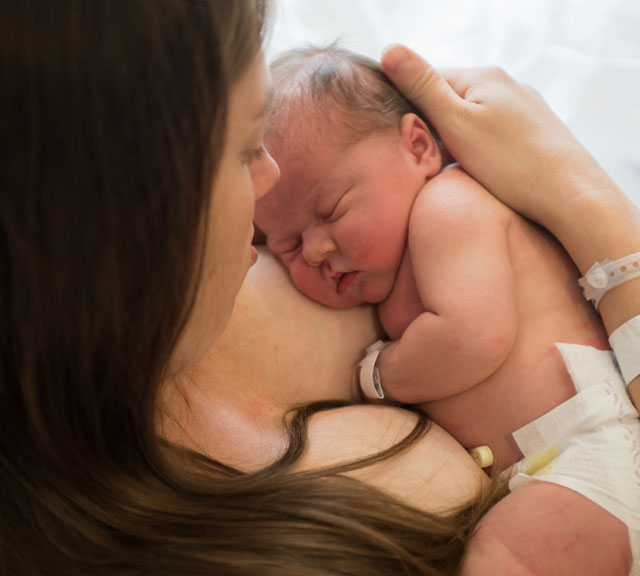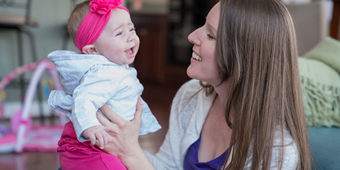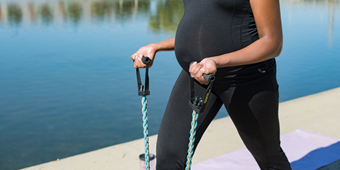Skin-to-Skin Contact: Bond With Your Newborn

Answer a few questions and we'll provide you with a list of primary care providers that best fit your needs.
Benefits abound when mother and baby experience skin-to-skin contact immediately after birth and during early infancy. You may have heard that holding your baby skin to skin helps soothe newborns, but did you also know that it affects their heart rate and brain development?
“It’s pretty amazing how much impact skin-to-skin contact has on both mother and baby,” says Maria Greene, RN, BSN, IBCLC, Premier Health lactation consultant. “And the effects are not just for the short term. Several research studies have shown the long-lasting results of early skin-to-skin contact between parent and child.”
Read on to learn how sharing that skin-to-skin bond can be good for both your baby and you.
 Skin-to-skin contact helps regulate a baby’s temperature. When mom and baby are skin to skin, the mother’s chest temperature adjusts to warm up a cool baby, or cool down a too-warm baby. This phenomenon is called “thermal synchrony.”
Skin-to-skin contact helps regulate a baby’s temperature. When mom and baby are skin to skin, the mother’s chest temperature adjusts to warm up a cool baby, or cool down a too-warm baby. This phenomenon is called “thermal synchrony.”- Skin-to-skin contact increases the maternal bond. One study followed mothers and babies who experienced skin-to-skin contact right after delivery compared to mothers who only viewed their child briefly immediately after birth. Days later the mothers who had skin-to-skin contact were shown to be more comfortable caring for and handling their babies. One year later those same mothers were found to touch, hold and interact with their children more.
- Skin-to-skin contact can help keep heart and breathing rates stable. Newborns panic when they are separated from their mother immediately after birth. That separation causes stress, which can increase both heart and breathing rates. Being skin to skin with their mother reduces stress and helps keep a baby’s heart rate and breathing normal.
- Babies cry less when they are skin to skin with their mother. Being close to their mother is natural for babies. Studies show that babies cry less when skin to skin with their mothers than babies who have been separated from mom.
- Human touch is an integral part of brain development. Touch and movement have been shown to be the basic building blocks for brain and social development. Early skin-to-skin contact helps to set a pattern for continued holding, carrying and touching.
- Moms who have early skin-to-skin contact breastfeed more and longer. When babies are placed skin-to-skin on their mother after delivery, research has shown that they follow a series of steps to familiarize themselves with their mother, eventually making their way to the breast on their own to begin breastfeeding. The research results are so strong, in fact, that the American Academy of Pediatrics now recommends that immediately after delivery all healthy infants be placed in direct skin-to-skin contact
 with their mothers as soon as possible and at least for the first hour.
with their mothers as soon as possible and at least for the first hour.
“The beauty of skin-to-skin contact is that it’s easy, both mom and dad can participate in it, and the whole family benefits from it,” Greene says. That closeness is important not only in the hospital after birth, but also once you’re home and getting to know the new addition in your family.
How to Hold Your Baby Skin to Skin
Find some good times throughout the day when skin-to-skin works best for you, your baby, and your partner. This might be during feedings (whether by breast or bottle), right before a bath, or just before putting pajamas on for bedtime.
Being skin to skin with their mother reduces stress and helps keep a baby’s heart rate and breathing normal.
Place your baby in a diaper only. Moms, remove your bra. Hold your little bundle directly against your bare chest. Make sure your baby’s head is turned to the side, so he or she can easily breathe, and hold your baby close enough for you to kiss the top of his head. Your body will keep him warm. It’s fine to drape a thin blanket over his back. All you need to do after that is sit quietly and enjoy being close and together.
Answer a few questions and we'll provide you with a list of primary care providers that best fit your needs.
Source: Medscape; American Academy of Pediatrics; Maria Greene, RN, BSN, IBCLC, Premier Health lactation consultant





